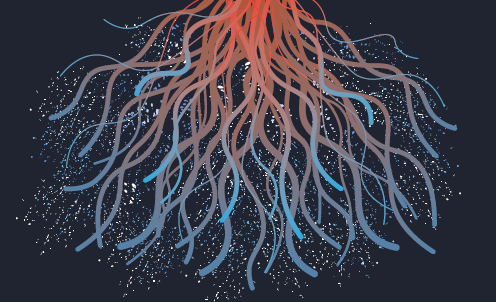Alternative Approaches to Pain and Inflammation
Pain and inflammation can be simplified to the tell-tale signs of uncomfortable sensation, redness, heat and swelling. However, a deeper look reveals insight to the powerful communication pathways operating within the whole body system

Understanding the types of pain
The two main types of pain are known as nociceptive and neuropathic pain – each with distinct characteristics that may require different treatment approaches.
Nociceptive pain is the most common type of pain and occurs when the nociceptors in the body detect noxious stimuli that have the potential to cause harm. This includes mechanical pressure, chemical toxins and extreme temperatures. The receptors in turn send electrical signals via the nervous system to the brain, leading to the perception of pain.
Neuropathic pain, which can be referred to as a ‘complex chronic pain state’, is associated with damage to the neurons responsible for the pain signalling pathways. Regardless of noxious stimuli, messages of pain are sent to the central nervous system. This can develop from infections, health conditions such as diabetes, surgery or injury. Norman Doidge, psychiatrist, psychoanalyst and renowned author of ‘The Brain’s Way of Healing’, suggests that chronic pain may be defined as a ‘learned’ pain, indicating the body’s alarm system is stuck in the ‘on’ position after an acute pain episode has not been resolved, leading to damage of the central nervous system.
For nociceptive pain, the first-line of orthodox management tends to be pharmaceutical analgesic medications such as paracetamol, ibuprofen and aspirin. For more severe pain, prescription opioids may be offered. The mechanisms of action of the medications differ but have a common goal to help disrupt the transmission of pain signals. These options may be helpful for acute short-term pain relief but may not provide much benefit for chronic pain.
Extended use of pharmaceutical pain relief medications may lead to further damage such as stomach ulceration, increased risk of strokes and liver damage. Opioids can also be addictive. Our brain makes its own opioid-like substances to block pain; pharmaceutical opioids attach to our opioid receptors. According to psychiatrist-turned-pain-specialist Dr Michael Moskowitz, once we saturate all our natural opioid receptors the brain produces new ones. The brain becomes less responsive to long-term opioids, thus making one more sensitive to pain, in turn more dependent on drugs, which can worsen chronic pain.
Chronic injury makes cells in the pain system fire more easily and causes pain maps to enlarge their ‘receptive field’. This means that we begin to feel pain over a greater surface area. As pain maps enlarge, there is ‘spillage’ into adjacent pain maps leading to ‘referred pain’.
Research findings indicate there is on-going competition in the brain for how it is used. Activities the brain performs regularly take up increasing amounts of space, resulting in ‘theft’ of resources from other areas. The same areas in the brain that ‘fire’ in chronic pain also process thoughts, sensations, images, memories, movements, emotions and beliefs – when they are not processing pain. This could explain why we can’t concentrate, become irritable, have emotional outbursts, don’t move gracefully and can’t tolerate certain sounds and light when we are in pain. Our brain has been hijacked by the pain signal. This may be heightened when we are in chronic pain because when an area of the brain is processing acute pain, approximately 5% of neurons in that area are dedicated to processing pain; in chronic pain this can increase to 15–25%.
Treating chronic pain concerns requires a multi-faceted approach, which may include natural pain relief options as part of a comprehensive treatment plan.
Extensive analysis is currently being undertaken on nutrients that may have applications on the cannabinoid receptors. Palmitoylethanolamide (PEA) is an endogenous fatty acid amide belonging to the endocannabinoid family that has proven analgesic and anti-inflammatory effects in chronic pain management studies. It could also be helpful for pain management in older patients where traditional analgesics may lead to high risk of adverse effects.
Inflammation – the body’s self-defence response
Inflammation is our body’s natural defence mechanism to remove harmful stimuli and initiate the healing process. However, like pain, it has the potential to become a chronic and lingering issue if it fails to eliminate the initial cause of inflammation.
Inflammatory cytokines are produced to protect us from infections and damaged cells. If not resolved short-term, these cytokines can disrupt the communication processes throughout the body. For example, in the endocrine system, signals from hormones and hormone sensitive tissues can be blocked by cytokines leading to endocrine disruption. When the body’s inflammatory responses become chronic, multiple systems are likely to be affected leading to further symptoms. So many modern diseases, including heart disease, depression, cancer, Alzheimer’s and autoimmune diseases occur in part because the body’s immune system produces excess chronic inflammation.
Key triggers for inflammation include:
- Pro-inflammatory foods: sugar, alcohol, caffeine, processed foods, trans/damaged fats, processed meats and for many also includes dairy and wheat/gluten
- Infections: viruses, parasites, bacteria and fungi/mould
- Chronic oxidative stress contributed by lifestyle factors such as smoking, lack of exercise, lack of sleep, stress and environmental toxins
The role of functional testing in pain and inflammation
There is a broad approach that can be taken in supporting the management of pain and inflammation. However, a more personalised and targeted application is possible with recent developments in genetic testing, for example. Research indicates that chronic pain may be highly heritable so screening for markers associated with oxidative stress, inflammation and methylation plus accessing information on key neurochemical pathways (e.g., serotonin, catecholamine, dopamine, opioid and endocannabinoid) can elucidate valuable insights into genetic influences on pain and inflammation.
If food intolerances are suspected, consider food antigen testing that includes testing IgG with Complement, to get a deeper insight into which foods could be contributing to chronic inflammation. These trigger foods can then be eliminated for a period of time to support a reduction in inflammation levels.

Managing inflammation via diet and lifestyle
Diet is a very powerful tool to help reduce inflammation. Increasing one’s intake of vegetables, fruit, nuts and seeds, wholegrains, purified water, omega-3 essential fatty acids from oily fish, herbs and spices such as cinnamon, turmeric, ginger, garlic and parsley are a few small and powerful changes when maintained over time.
In addition, address key factors that may be fuelling chronic inflammation by:
- Resolving infections
- Gut healing
- Optimising sleep
- Daily exercise
- Reducing or avoiding environmental toxins, getting out into nature and implementing stress management tools
For those having to deal with it day-in and day-out, chronic pain can take a significant toll on their mental and physical wellbeing. Thankfully, increased research along with targeted functional testing means we now understand pain and inflammation with more precision than ever before; equipping practitioners to apply personalised and highly effective treatment strategies.
Share:
Related Posts

Why Would I Test Positive To Foods On A Dietary Antigen Test That I Don’t Eat?
Written by Precision Point Diagnostics | 2025 True food allergies are when the body develops antibodies against a particular food, or a related food. Patients

Mitochondria: The Overlooked Link in the Gut-Brain Axis
Written by Dr Sarah Daglis | 2025 The gut-brain axis is well-established, but there’s more to this dynamic relationship than meets the eye. A vital

Unlocking Respiratory Resilience Through Functional Medicine
Article written by Dr Michelle Clark Naturopathic Doctor Clinical Education Manager, FxMed Published 1 September 2024 People take supplements to improve or optimize their health.

AHCC: Unlocking the Immune Intelligence of Shiitake Mycelia
Article written by Jessica Sanders BSc. (Psy), Dip Nat, Dip Med Herb Technical Projects, FxMed Published 1 September 2024 People take supplements to improve or

Life After Weight Loss Meds
Kathi Head, ND February 20, 2025 You would have to have been spending glorious hours lying on the beach on a desert island not to



